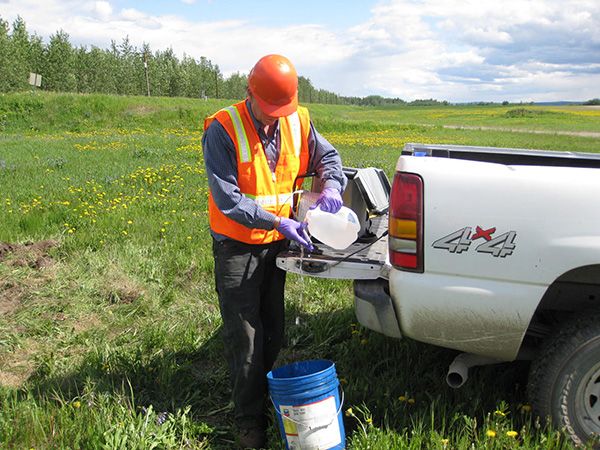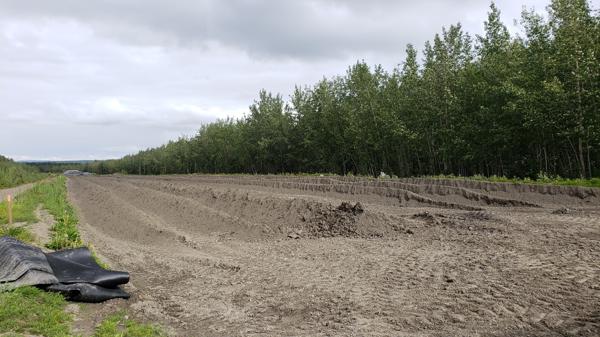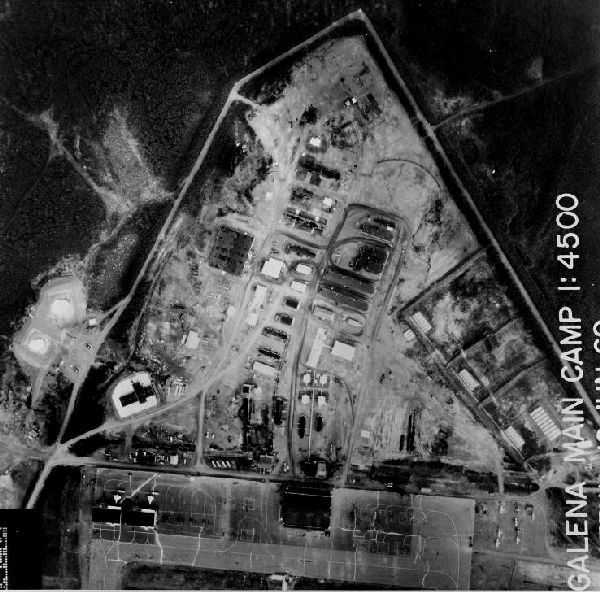Galena Air Force Station
- View detailed information from the database on this site.
- Database Name: Galena AFS/Airport - Sitewide
- Status: Active
- Location: Galena
- Latitude: 64.741389
- Longitude: -156.953333
This site has a Restoration Advisory Board, which involves the community
- DEC Contaminated Sites contact:
- Tim Sharp, Project Manager
- 907-451-2131
- U.S. Air Force contacts:
- Christiana Hewitt
- Air Force Civil Engineer Center
- 866-725-7617 (JBSA Lackland, Texas)
- Click on photos or maps for larger versions.
- Contacts updated: 9/10/2025
- Summary updated: 9/10/2025
Site Narrative
History
The former Galena Forward Operating Location (FOL) is located on the northern bank of the Yukon River in the City of Galena, approximately 45 miles east of Nulato, 270 miles west of Fairbanks, and 350 miles northwest of Anchorage.
The City of Galena, Alaska was established in 1918 as a supply and trans-shipment point for lead ore (galena) mining prospects south of the Yukon River. The location was on the site of a former Athabaskan fish camp recorded in the 1880 Census map as Natulaten. A school was established in the mid-1920s and a post office opened in 1932. The population of Galena in 1940, the year the Civil Aeronautics Authority (CAA) began the first buildup in Alaska, was 30 people. Most residents were Athabaskan Indians who moved there from nearby villages on the Yukon River.
In 1941, the federal government set aside 5,282 acres for the CAA to establish an air navigation facility as part of an overall civilian airport construction program in Alaska. The CAA selected Galena because of its central location in interior, western Alaska. Prior to World War II, the military had no presence in Galena. From August 1942 until September 1945, Galena supported the lend-lease transfer of American aircraft to the Soviet Union. In 1942, an Army post was established in Galena and the CAA officially turned operation of the airfield over to the military on July 1, 1943. At the end of WWII, the Army declared the airfield surplus and CAA resumed control of the airfield and facilities.
The newly created United States Air Force (USAF or Air Force) was the next military service to use the Galena Airfield, beginning in 1945. The 11th Air Force was designated the Alaskan Air Command (AAC) and in early 1951, the AAC negotiated an agreement with CAA for joint use of Galena Airport. The Galena Airport was made the site of the regional long-range radar for aircraft control and warning, as part of the conversion to minimally attended radar in 1984.
By 1993, all permanent military personnel and aircraft had withdrawn from Galena. Many of the previous USAF facilities were transferred to federal, state and local entities for their exclusive uses. The remaining facilities reverted to caretaker status and a contractor was hired to maintain the properties. On August 25, 2005, the Base Realignment and Closure (BRAC) Commission voted unanimously to close the former Galena FOL.
Unique to the former Galena FOL is the fact that the Air Force operated facilities on a combination of land leased from the State of Alaska and land that was reserved for continued federal use after Alaska became a state through the 1966 deed. From the initial construction by the CAA (later the Federal Aviation Administration [FAA]) in 1941, through use by the Army from 1942 until the end of WWII, and at the beginning of the USAF build-up at Galena in the 1950s, Alaska was still a U.S. territory and the land in Alaska was federally owned. In 1959, Alaska became the 49th state and the federal government granted the new state 28 percent ownership of its total area. In the 1966 Omnibus Deed, as part of the land selection process, all lands within the Galena Airport boundary were deeded to the State of Alaska. The Deed reserved uses of certain lands on Galena Airport to specific federal entities.
Under 1990 BRAC (P.L. 101-510; as amended), the Air Force was required to permanently close its mission and terminate all military activities at Galena FOL by September 15, 2011. All former Air Force facilities were declared excess and/or surplus and the facilities were either demolished or conveyed. The Air Force has released reserved land and terminated its leases in Galena, allowing property to transfer to the City of Galena, Galena school district, the Alaska Department of Transportation and Public Facilities (ADOT&PF), and the US Fish & Wildlife Service (USFWS).
The Air Force remains responsible for the cleanup of residual contamination resulting from Air Force activities. Cleanup must be conducted in accordance with Comprehensive Environmental Response, Compensation, and Liability Act (CERCLA) or State of Alaska requirements, which includes the selection and implementation of remedies and applicable land use controls/ institutional controls (LUCs/ICs). LUCs/ICs are implemented through agreements with the primary landowners, the City of Galena, and ADOT&PF. The Alaska Department of Environmental Conservation (DEC) is overseeing the cleanup to ensure that it meets State of Alaska standards.
Currently, ADOT&PF operates and manages the Edward G .Pitka, Sr. Airport and conducts its Galena operations out of a building that the Air Force formerly used for vehicle maintenance. Additionally, the City of Galena operates the Galena Interior Learning Academy (GILA) boarding school out of refurbished former Air Force buildings.
A major flooding event occurred in Galena in May 2013. Most of the structures in the town saw significant flooding and many were swamped by as much as seven feet of water.
Environmental Cleanup

DEC’s Dennis Shepard is shown decontaminating a water interface probe during a groundwater monitoring well inspection for an old landfill at the Galena Airport project in the summer of 2012. The landfill is one of several that the Air Force used when the base was active. (DEC Photo)
The USAF and DEC work with local stakeholders via the Galena Technical Project Team (TPT) to address environmental concerns. In addition, communication with Galena community members occurs via a Restoration Advisory Board (RAB), which involves residents of Galena, Native group stakeholders, State and Federal agencies and the City of Galena. Semiannual TPT and RAB meetings are generally held each April and October.
A preliminary assessment (PA) was conducted in 2011 for the former Galena AFS. The PA identified more than 50 sites as potentially contaminated. An additional Site Inspection (SI) was recommended for 27 of the sites. The sites were investigated during 2010-2016 under an approved Work Plan for Site Inspection, Remedial Investigation and Site Characterization, Former Galena FOL, Alaska (August 2010). Samples were collected to evaluate potential releases of contamination, migration pathways and potential receptors (human and environmental). Sites with non-petroleum contaminants were identified as CERCLA-regulated and required Method Four Risk Assessments to evaluate risk to human and ecologic receptors.
Public Health and Environmental Concerns
Contamination from the following petroleum and other hazardous chemicals has occurred at the Galena Airport over the years:
- Petroleum, Oils and Lubricants (POL): Petroleum-based fuels were used for facility energy needs, heating and aircraft refueling. Various oils, lubricants and antifreeze were used for maintaining the aircraft and other vehicles at the base. Crushed drums containing POLs and tar have been documented around the Galena FOL area routinely, usually due to erosion of the bank of the Yukon River.
- Solvents: Solvents such as tetrachloroethene (PCE) and trichloroethene (TCE) were used to maintain vehicles, aircraft, ammunitions and electronics.
- Polychlorinated biphenyls (PCBs): The various facilities at Galena utilized electrical transformers, which contained PCB oil. In addition, several sites have been identified as storage areas for PCB transformers and one former disposal site has confirmed PCB soil contamination.
- Pesticides: Widespread, low-level occurrences of pesticides found at the airport suggest historic area-wide applications for insect control.
- Metals: Metal contamination from leaded gasoline, aviation gasoline and waste oils are a primary concern at the Galena Airport. There is also a concern that, waste contaminants were discarded or flushed down wastewater or floor drains at some sites. Contaminants in drain fields or landfills may include lead, mercury and other metals.
- Ordnance: Due to the historical use of military munitions at Galena Air Station, several sites on or adjacent to the airport were investigated for discarded military munitions, unexploded ordnance, munitions debris, or munitions constituents.
- Perfluoroalkyl Substances (PFAS): These compounds are a class of synthetic fluorinated chemicals used in industrial and consumer products, including defense-related applications and firefighting foams, such as aqueous film forming foam (AFFF).

Advancement of a Horizontal Well at Galena FOL in summer 2017. The horizontal wells are approximately 1,000 ft. long and 45-75 ft. underground. Air will be injected into the wells to accelerate bioremediation of petroleum contamination in the soil and groundwater.
Potential pathways for contaminant exposure include: direct contact with contaminated surface and subsurface soils, ingestion of contaminated groundwater by contaminant migration to drinking water wells or to the Yukon River, inhalation of harmful vapors migrating from subsurface contamination into buildings (called vapor intrusion), and the accumulation of contaminants in wildlife harvested for subsistence.
Current Status
Site work and remedial investigations (RIs) conducted in 2010-2016 have enhanced our knowledge of contaminant concentrations in soil and groundwater. RI reports have been prepared to document the extensive investigation and the total extent of contamination identified at the CERCLA sites. As part of the CERCLA Remedial Investigation/Feasibility Study (RI/FS) process, Risk Assessments have determined the associated risks to humans and the environment from site contaminants. Feasibility Studies have been completed to evaluate different approaches and costs associated with cleanup of the contamination. The Galena Airport is currently in the Record of Decision (ROD) phase of the CERCLA cleanup process. The ROD documents the extent of contaminants in soil and groundwater, the cleanup levels or remedial action goals, and the cleanup approach for the sites under investigation. The development of a Remedial Design/Remedial Action (RD/RA) or cleanup plan, and implementation of selected remediation approaches is complete at most sites.

The BRAC group operates a landfarm at the former Campion AFS airstrip, approximately 6 miles east of Galena. This photo shows windrows of petroleum-contaminated soil that were undergoing treatment in the landfarm. The landfarm has not been tilled after 2023, and is currently being sampled and evaluated for PFAS contamination.
- The USAF is employing a variety of remediation systems at Galena:
- Soil-vapor extraction (SVE): Soil Vapor Extraction removes volatile fuels such as gasoline or solvents from the ground by creating a vacuum that draws soil vapors into the wells. The low-level volatiles are discharged to the air. Emissions are treated prior to discharge, if needed.
- Bioventing/Air Sparging: Bioventing and Air Sparging are types of subsurface aeration systems. Air is injected either into soil (bioventing) or into groundwater (sparging) to add oxygen. Naturally occurring microbes in the ground need the oxygen to degrade petroleum hydrocarbons. Fuels are broken down over time.
- Injection of Treatment Amendments: At several Galena sites, amendments will be injected into the ground to enhance or accelerate biological activity or transforms fuel and chlorinated solvent contamination to a less hazardous end-product in groundwater. The amendments are pumped into the ground through a temporary borehole. When done, the borehole is grouted up. Injection locations are typically 20 feet apart to ensure that the amendments cover the entire area.
- Excavation of contaminated soil: Contaminated soil was previously either treated at the landfarm or sent off-site for disposal. However, the landfarm has not been tilled after 2023, and has recently confirmed to be contaminated with PFAS, which cannot be treated via landfarming. Currently, the landfarm is not receiving any additional contaminated soil nor is soil being considered for beneficial reuse at the landfill prior to sampling for PFAS. The Air Force and DEC are currently working together to evaluate alternative remedial actions for both contaminated soils in the landfarm and soil that is not able to be added to the landfarm at this time.
- The USAF conducts annual groundwater monitoring of the Air Force wells located in Old Town and the results are included in reports that are posted to the Administrative Record (AR) which is available to the public at: http://afcec.publicadmin-record.us.af.mil/
- Land use controls (LUCs) are placed on areas where contamination may present a risk to people. For excavation and construction work, this generally involves working with Alaska Department of Environmental Conservation on preparing a work plan to ensure that any contaminated soil or groundwater is handled properly. The installation of drinking water wells is prohibited in areas with groundwater contamination. New buildings must be constructed in areas where vapor intrusion is not a concern or can be mitigated. DEC maintains a land-use control map for Galena.
Emerging Contaminants: Perfluoroalkyl Substances (PFAS)
PFAS are considered an “emerging contaminant” because they:
- Have possible pathways to enter the environment
- Are persistent in the environment and resistant to typical environmental degradation processes
- Present a potential unacceptable risk to human health or the environment
The USAF is responding to potential releases of PFAS throughout the United States in response to the US Environmental Protection Agency’s (EPA) release of provisional health advisories for PFAS in May 2016. As of November 2017, cleanup levels have not been universally adopted for PFAS; however, DEC adopted cleanup levels for two PFAS compounds (perfluorooctane sulfonate [PFOS] and perfluorooctanoic acid [PFOA]) in November 2016. The most common source of PFAS for Air Force sites is AFFF, which was used for fighting aircraft fires and in fire suppression systems for facilities that store fuels.
A PFAS Site Inspection (SI) was completed at Galena FOL in 2016. As a result, five areas of contamination were identified:
- Area 1 - Fire Protection Training Area (FT001)
- Area 3 - Building 1549 (Old Fire Station)
- Area 4 - Building 1556 (Fire Station)
- Area 5 - Building 1573 (Vehicle Maintenance Facility)
- Area 9 - Sanitary Sewer System
These areas are tracked under Site CG109 and FT001, respectively. ADOT&PF owns AFFF Areas 1, 3, 4, and 5. The City of Galena owns AFFF Area 9 (Sanitary Sewer System). Additional investigation of identified PFAS sites at Galena FOL are following the CERCLA RI/FS process.


